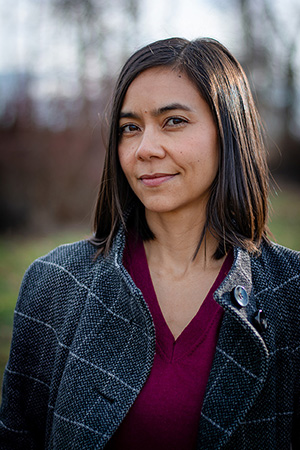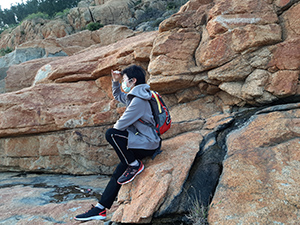Many Selves: Kathy Mak interviews Corinna Chong

Past contributor Kathy Mak talks with Corinna Chong, whose story “Punctum” appears in our spring issue #226. They discuss emphasis on imagery, the private vs. public self, and letting the story guide character development.
Read an excerpt of "Punctum" here.
Corinna Chong‘s first novel, Belinda's Rings, was published by NeWest Press in 2013, and her reviews and short fiction have appeared in magazines across Canada, including Grain, Ricepaper, Room, Riddle Fence, The Fiddlehead, and PRISM international. The Whole Animal, a collection of short stories, was published by Arsenal Pulp Press in 2023, and includes “Kids in Kindergarten,” which won the 2021 CBC Short Story Prize, and “Love/Cream/Heat,” which was selected for the Best Canadian Stories 2024, published by Biblioasis. Bad Land, her second novel, will be released in Fall 2024 with Arsenal Pulp Press. Since 2011, Corinna has lived on unceded Syilx/Okanagan territory (Kelowna, BC), where she teaches a range of courses in English literature, creative writing, and design as part of the Diploma in Writing and Publishing at Okanagan College.
Congratulations on publishing your short story “Punctum” with The Malahat Review! I really enjoyed reading it. The way the masks are described is vivid and grotesque, which makes them alive in their own way. They enamour the protagonist Ivy from really seeing and understanding the people around her, and act as a catalyst to the disconnect in her relationships, especially with her half-brother and ex-partner. I’m curious what drew you to incorporating masks into “Punctum,” and how did this story come to be?
Thank you for reading “Punctum” and offering these thought-provoking questions! This story began at the Banff Centre for Arts and Creativity, where I was lucky enough to spend two weeks writing. I was browsing the collection of visual art books at the fantastic library there and stumbled across a retrospective on the work of the photographer Cindy Sherman. I’d written a paper on Sherman as an undergraduate visual art student and looking at the book rekindled my fascination with her work, particularly her abject pieces, some of which are extreme close-ups of grotesque, rotting food, and others belonging to a series of self-portraits that depict her as exaggeratedly ugly and even monstrous. The idea to write a story about an artist who makes masks out of food arose from there. I thought it would be interesting to explore a character who strives to cultivate a kind of external ugliness, and question what might be at the heart of that impulse.
Ivy explains the masks are about a “performance of self”: “like the disconnect between the projected self and the real self. [Like] laying claim to a racialized identity in a way that feels kind of fake.” This resonated with me because there are many selves we project, depending on where we are and how we’re feeling. It made me think about the self that attends poetry readings and literary events, and how it’s different from the self that writes under the glow of the kitchen lights. As someone in diaspora, I feel I can never wholly connect with my Chinese heritage and Canadian culture. Do you have a similar disconnect between the projected self and real self? What were you trying to achieve when exploring this theme?
I suspect this rings true for all of us to some degree; the self we project to others is necessarily different from the self we harbour inside. I certainly feel this as a biracial person who was born and raised in Canada with little connection to my Chinese heritage. And like you, I also feel this as a writer; like many writers, I am an introvert and not at all a natural performer, so I definitely struggle with the disconnect between the private self and the public self. With this story, I wanted to play with the various layers of self by using Ivy’s masks as a metaphor for the artificial persona she is trying to cultivate. Ironically, while she claims to be blatantly, self-consciously illuminating this through her art, the masks are a cover for the inner conflict that she doesn’t yet know how to acknowledge. She focuses on her own suffering, seeing herself as a victim throughout the story, while being willfully callous and even blind to the very real struggles of the people around her, namely Javi and Cedar.
In addition, I think the idea that the projected persona of the artist differs from the “real” person that is the artist’s private self is also at play in the story. Ivy is desperate to be seen as a serious, vital, and edgy artist, to the point where she loses all perspective and allows the idea of the masks to spiral into disaster. By the end of the story, she realizes that the concept wasn’t actually an authentic one, nor were her perceptions of her relationships, which were being filtered through this lens. Ultimately, the “punctum,” or the quality that elicits an earnest and authentic emotional response, is missing, in both her art and her relationships.
Cedar, Ivy’s ex-partner, is never physically present in the story. But we learn about her character and their fraught relationship through Ivy’s perspective, which still makes her very much flesh and blood to the reader. How do you create your characters? Do you create profiles for them that list their traits and characteristics, or do you let the story guide you into shaping who they are?
The characters in this story have become very real to me through the process of writing, so I’m glad that Cedar emerges as a three-dimensional character for you! I don’t typically map out characters or create profiles for them. My characters usually arise out of the deep-seated internal conflicts that I find so fascinating to explore. One of the things that inspires me to write is an interest in people—how wonderfully complicated they can be, and what drives them to make decisions, good and bad. As Whitman would say, we contain multitudes, and I think the best characters in literature are those that can’t be easily pinned down. Letting the story organically guide the way the characters develop is one of the most magical and rewarding parts of writing for me. Often, I start by loosely modelling characters on people I know, and this helps me to develop a distinct personality and a clear voice for them. But while they contain elements drawn from my own experiences, they end up taking on their own personalities as the story evolves.
From your website https://www.corinnachong.com/, your bio states you have a BA and MA in English (Creative Writing), and a BFA in Visual Art (Photography). There’s also a section on graphic design work you do. How does your writing influence your photography/graphic design and vice versa? Do you foresee intermixing these creative disciplines into your next project, or do you prefer to keep them separate?
I think my interest and background in visual art comes through in the way I write with a lot of emphasis on imagery. My characters are sometimes reflective of this background as well; “Punctum,” of course, features an artist as the main character, and another story I wrote a few years ago called “Fixer” is about a photographer at an artist’s retreat. Juggling a full-time teaching job alongside writing hasn’t left me a lot of time for pursuing visual art or design projects lately, which is perhaps another reason why I’m drawn vicariously to artist characters.
While I think that visual art and literary art involve many of the same challenges and rewards, I haven’t yet been inspired to pursue a project that combines the two. I don’t have any particular hang-ups about doing this; I’m intrigued by other artists who do, but for whatever reason the two disciplines have always been separate for me. That said, I find it very helpful to channel my visual art brain into the writing process, particularly when it comes to revision. I tend to approach visual art with more intuition than writing, so I’m much more inclined to trust my gut and take risks. When I find myself allowing my perfectionist mindset to block me from moving forward with a piece of writing, I try to think about swapping out my analytical writer’s brain for my intuitive artist’s brain.
What are you reading or planning to read? Feel free to talk about any upcoming projects, endeavors, or anything else you’d like to share. The floor is yours!
My TBR pile is perpetually towering. There are so many great books to read and not enough time! I usually have several books going at once. I’m currently reading an Advanced Review Copy of Jade Wallace’s Anomia, a novel that manages to artfully blend mythic elements with a gripping murder mystery while challenging gender binaries in a way I’ve never seen done before. Look out for it this summer! I’m also reading Tainna, a collection of short stories by the Inuit writer Norma Dunning, and Mark Anthony Jarman’s collection of selected stories, Burn Man. I just picked up a copy of Anne Fleming’s brand-new novel, Curiosities, which I can’t wait to dig into. As for my own upcoming projects, I have a novel called Bad Land coming out with Arsenal Pulp Press in September. It’s set in the badlands of Drumheller, Alberta, and it’s about an awkward loner named Regina who uncovers a terrible secret about her estranged brother and his peculiar six-year-old daughter. You can read more about it (and pre-order!) here: https://arsenalpulp.com/Books/B/Bad-Land

Kathy Mak









